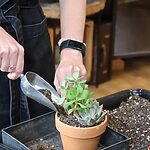Table of Content
- About
- Light
- Humidity
- Water
- Soil
- Pests & Diseases
- Feed
- Pruning & Propagating
- Troubleshooting & Tips
- Toxicity
- Species
- Disocactus anguliger
About
The Fish Bone Cactus is not your regular cactus. Unlike most cacti that dwell in desert-like environments, this vivid trailing epiphyte (a plant that grows in or on the trunks and limbs of other plants and trees) is native to the tropical evergreen forests of Mexico.
Found only in these forests high above sea level in warm humid environments. The official name for this unusual cactus is Disocactus anguliger, some may still know it as Epiphyllum anguliger but after recent molecular research, the plant was reclassified into the cactus genus and family. It also goes by the common names Fish Bone Cactus, Zig Zag Cactus, and Orchid Cactus. The first two names do a good job of describing the rich green jagged tendrils that burst out of the centre of the plant and hang down towards the ground. But it has been given the name Orchid Cactus because of the stunningly beautiful flower display it can produce.
Often cactus flowers are very impressive, they take a long time to form and when they do they don’t disappoint and this cactus is no different. Producing a large vivid star-looking flower that blooms with bright neon pink on the outside and a pale creamy white in the centre, it is well worth a quick internet search if you haven’t seen them before. But like most cactus flowers this is a short-lived experience with the flowers lasting a day maybe two at best. You will also need to be patient as the Fish Bone Cactus won’t start producing flowers until it reaches at least three years old.
Overall this plant is perfect for those who may not have the environment to house a dessert-style cactus but still want to be part of the club. This very forgiving plant can tolerate lower light conditions and a touch of neglect making it a great choice for beginners or those who often forget to water their plants but still want a touch of green in their homes.
Light
The best-growing condition for this plant is to place it in the brightest indirect light you can find. It will also thank you for being exposed to a few hours of direct sunlight preferably in the morning or late afternoon.
While it will tolerate a touch of shade the less light it receives the more likely it will hinder the chances of flowering. They need good light all year round to be able to develop and produce flowers.
Too much direct sunlight will cause dark patches on the surface of the plant, this is the equivalent to scorch or burning. These patches can be cut off or trimmed away but be sure to always use sterile scissors or secateurs.
Humidity
It is important to remember even though this plant is a cactus it hails from a humid jungle and won’t perform at its best if kept in just a regular household humidity of 40%. It will ideally want to be kept around 55-75% humidity, so regular misting will be required to keep the plant happy.
It is best to mist in the evening as the sun is setting, it’s always best to avoid misting your cactus during the day. When water sits on the surface of the leaf and is exposed to direct sunlight this can cause scorch marks to happen quicker than usual.
Pro Tip
The best way to maintain high humidity is to use a humidifier placed about a metre away from your plant to provide high ambient humidity. Alternatively, you could place your plant on an undertray filled with Leca pebbles or small stones that are sitting in a shallow layer of water. Make sure the plant is not submerged in any water as this can lead to root rot. As the water from the undertray evaporates from the surface of the pebbles or stones it will keep humidity levels high exactly where you need it most.
Water
The Fish Bone Cactus will want to be treated more like your other herbaceous houseplants and less like a cactus when it comes to watering. It’s important not to let the soil completely dry out and is best to always keep it slightly damp.
During the summer months, regular watering will be crucial to keep it growing and discolouration of leaves is often the first sign of underwatering.
It’s also worth noting that this cactus can be especially sensitive to impurities and chemicals in the water. It is always best to use rainwater where possible, if not tap water that has been left to settle for around 24 hours to allow any chemicals to evaporate.
Top Tip
Always water from the base of the plant. Sitting your plant in an under tray and allowing it to absorb water from the base will reduce the risk of overwatering and is a good preventative measure for fungus gnats. Remember to always set a timer from the minute the plant goes in the water, we don’t want any forgotten casualties on our hands.
Pro Tip
Before you water your plant, take note of the weight of the pot. Once you’ve watered the plant, try to notice the difference in weight from before. Now you can quickly tell if your plant needs water by just lifting it up.
Soil
While you could use a specific Cacti compost Fishbone Cactus prefers well-drained soil that can retain moisture between watering and has more nutrient density. So a better-suited soil mix for this will be nutrient-rich, allow for good aeration, slightly acidic, and free-draining with a smidge of water retention. A 50/50 mix of aroid potting mix and Cacti compost would be best, but you can always add perlite for some additional drainage, and vermiculite for added water retention. With a combination of these, you can provide the best environment for your plant to thrive.
Pests & Diseases
It is good practice to regularly check your plants for any signs of aphids, red spider mites, mealy bugs, and thrips. You may notice some signs of distress and allow yourself time to prevent a full-blown attack.
The most common pests that are attracted to Fishbone Cactus are scale and mealybugs and there is often a result of a lack of watering when the plant is in a weakened state.

Check our video on homemade pest remedies or head over and read are Fungus Gnat Fact Check
Feed
Thriving plants will need regular feeding to keep the nutrients at optimal levels in the soil. Like most houseplants, to promote healthy roots, stems, and leaves they will need a steady supply of nitrogen, phosphorus, and potassium. The most important is nitrogen to keep their leaves large and looking their best.
A good liquid houseplant feed can be applied every four weeks during the growing season. There’s no need to feed during the winter while the plant is dormant. Also once the cactus is in bloom stop all feeding as this may cause the flowers to fail.
Top Tip
A drop of houseplant feed in a mister bottle is a great way to feed your Fishbone Cactus via its foliage.
Pruning & Propagating
There is no need for regular pruning of your cactus to keep it happy but you may want to give it a trim every now and then just to neaten it up.
REMEMBER – Always use clean and sharp pruning scissors!
Fishbone Cactus is a great plant to propagate as cuttings take easily and will start producing a new root system relatively quickly. The best way to propagate is from cuttings.
Cuttings – Simply place your cuttings in a glass of rainwater and wait for up to 2-4 weeks to start seeing signs of new roots. You will need to regularly change the water to avoid a build-up of algae. Once you have substantial root growth you can place the cuttings into a small pot of Aroid mix
You can also put your cuttings straight into a jar with fresh sphagnum moss
This is probably the easiest way to propagate as it involves the least steps. Simply take your cutting at the node, find a jar or pot preferably with no drainage holes, fill it up with fresh moss and nestle your cutting in the centre. Fill up the jar with water so the moss has been evenly watered and then drain out all excess water making sure not to leave any at the bottom of the jar when standing upright. Now just keep an eye on your new cutting, checking the moss every couple of days to ensure it hasn’t dried out.
Troubleshooting & Tips
- If the stems of your cactus are staying thin and round and not becoming wide and flat this is often caused by the plant receiving insufficient light.
- The Fishbone Cactus normally blooms between autumn and winter. To help encourage your plant to produce flowers you can keep it in a slightly colder place than usual and reduce watering around mid to late October. If buds start to form you’re in luck! Return to regular watering and place the cactus back in a slightly warmer environment.
- Brown spots will occur if the humidity is too high or if there is water sitting on the surface of the leaf for a prolonged period of time.
- If the leaves of your cactus start to look wrinkled this is a sign of underwatering.
Toxicity
The Fish Bone Cactus is non-toxic and poses no threat to humans or pets. Another reason this is such a great addition to a houseplant collection.
Species

Disocactus anguliger
Disocactus anguliger, also known as the “Fishbone Cactus,” is a stunning plant that immediately catches the eye with its unique appearance. The succulent’s long, flat, and segmented stems twist and turn like the skeleton of a fish, creating a mesmerizing pattern that draws you in closer. The plant’s stems have a distinctive light green colour and are covered in small spines, giving it a delicate but rugged look.
If you enjoyed this guide head over to Articles & Blogs to learn more or check out our YouTube for even more useful information!











